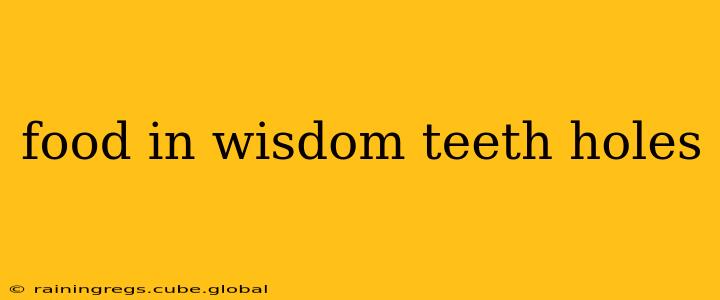Getting your wisdom teeth removed is a significant oral surgery procedure, and proper post-operative care is crucial for a smooth recovery. One common concern is what happens if food gets into the extraction sites. This guide will address that concern, and other frequently asked questions surrounding food and wisdom tooth extraction.
What Happens If Food Gets in My Wisdom Teeth Holes?
Getting food particles lodged in the extraction sockets is a real possibility, and while it's not ideal, it's not usually a major cause for alarm. Small pieces of food might get trapped, but your body's natural healing process will generally handle this. However, forcefully trying to remove food particles is strongly discouraged. This can dislodge the blood clot that's essential for proper healing, leading to a painful and potentially serious complication called dry socket.
Instead of digging around, gently rinse your mouth with saltwater (a teaspoon of salt in a glass of warm water) several times a day. This will help to loosen any debris and keep the area clean.
How Long Does It Take for Wisdom Tooth Holes to Heal?
The healing time for wisdom tooth extraction sites varies depending on individual factors like overall health, age, and the complexity of the extraction. Generally, it takes several weeks for the sockets to fully heal and close. You might see significant improvement within the first week, but complete healing often takes 6-8 weeks or longer.
What Can I Eat After Wisdom Tooth Extraction?
Initially, you'll need to stick to a liquid or soft food diet. This allows the extraction sites to heal without disruption. Suitable options include:
- Soups: Broth-based soups, blended soups
- Smoothies: Nutrient-rich smoothies made with fruits, vegetables, and yogurt
- Applesauce: Unsweetened applesauce
- Yogurt: Plain or flavored yogurt (avoid crunchy toppings)
- Pudding: Creamy pudding
- Mashed potatoes: Plain mashed potatoes without lumps
- Scrambled eggs: Softly scrambled eggs
- Oatmeal: Cooked oatmeal
Gradually, as the healing progresses, you can introduce more solid foods, but it's crucial to avoid anything that could get lodged in the sockets or require excessive chewing. Avoid hard, crunchy, or sticky foods for at least the first week or as directed by your oral surgeon.
Can I Rinse My Mouth After Wisdom Tooth Extraction?
Yes, rinsing your mouth gently with saltwater is recommended several times a day. This helps maintain cleanliness and promotes healing. Avoid vigorous rinsing or using mouthwash which contains alcohol as this can irritate the extraction sites.
What Should I Do If I Have Pain After Wisdom Tooth Extraction?
Post-operative pain is normal, but it should gradually decrease over time. Follow your oral surgeon's instructions regarding pain medication. If the pain is severe, persistent, or accompanied by other symptoms like excessive bleeding or swelling, contact your dentist or oral surgeon immediately.
What are the signs of a dry socket?
A dry socket is a painful complication that can occur after tooth extraction. It happens when the blood clot that forms in the extraction site dislodges or dissolves prematurely, exposing the underlying bone and nerves. Signs of a dry socket include:
- Severe pain: Usually starting 2-3 days after the extraction and worsening over time.
- Persistent bad breath: A foul odor emanating from the extraction site.
- Visible empty socket: The socket may appear noticeably empty without a blood clot.
If you suspect you have a dry socket, contact your oral surgeon or dentist immediately. They can provide appropriate treatment to alleviate the pain and promote healing.
Remember, every individual's healing process is different. Always follow your oral surgeon's specific instructions for post-operative care to ensure optimal healing and minimize the risk of complications. If you have any concerns, don't hesitate to contact your dentist or oral surgeon.
